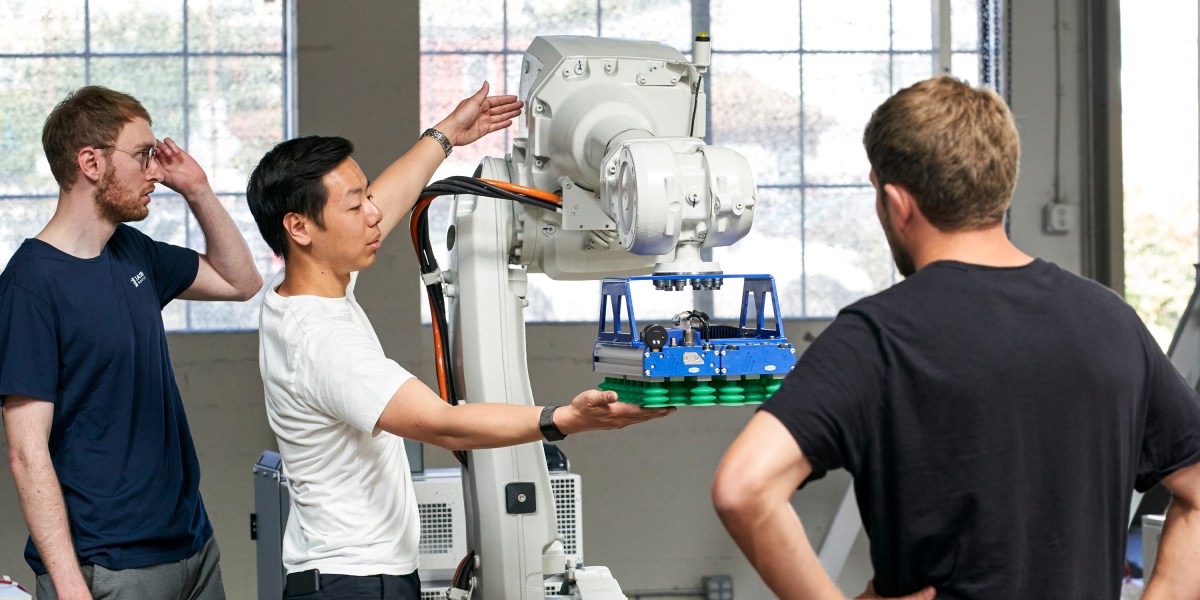After much trial and error, Jacobi’s founders, including roboticist Ken Goldberg, say they’ve cracked it. Their software, built upon research from a paper they published in Science Robotics in 2020, is designed to work with the four leading makers of robotic palletizing arms. It uses deep learning to generate a “first draft” of how an arm might move an item onto the pallet. Then it uses more traditional robotics methods, like optimization, to check whether the movement can be done safely and without glitches.
Jacobi aims to replace the legacy methods customers are currently using to train their bots. In the conventional approach, robots are programmed using tools called “teaching pendants,” and customers usually have to manually guide the robot to demonstrate how to pick up each individual box and place it on the pallet. The entire coding process can take months. Jacobi says its AI-driven solution promises to cut that time down to a day and can compute motions in less than a millisecond. The company says it plans to launch its product later this month.
Billions of dollars are being poured into AI-powered robotics, but most of the excitement is geared toward next-generation robots that promise to be capable of many different tasks—like the humanoid robot that has helped Figure raise $675 million from investors, including Microsoft and OpenAI, and reach a $2.6 billion evaluation in February. Against this backdrop, using AI to train a better box-stacking robot might feel pretty basic.
Indeed, Jacobi’s seed funding round is trivial in comparison: $5 million led by Moxxie Ventures. But amid hype around promised robotics breakthroughs that could take years to materialize, palletizing might be the warehouse problem AI is best poised to solve in the short term.
“We have a very pragmatic approach,” says Max Cao, Jacobi’s co-founder and CEO. “These tasks are within reach, and we can get a lot of adoption within a short time frame, versus some of the moonshots out there.”
Jacobi’s software product includes a virtual studio where customers can build replicas of their setups, capturing factors like which robot models they have, what types of boxes will come off the conveyor belt, and which direction the labels should face. A warehouse moving sporting goods, say, might use the program to figure out the best way to stack a mixed pallet of tennis balls, rackets, and apparel. Then Jacobi’s algorithms will automatically plan the many movements the robotic arm should take to stack the pallet, and the instructions will be transmitted to the robot.
JACOBI ROBOTICS
The approach merges the benefits of fast computing provided by AI with the accuracy of more traditional robotics techniques, says Dmitry Berenson, a professor of robotics at the University of Michigan, who is not involved with the company.
“They’re doing something very reasonable here,” he says. A lot of modern robotics research is betting big on AI, hoping that deep learning can augment or replace more manual training by having the robot learn from past examples of a given motion or task. But by making sure the predictions generated by deep learning are checked against the results of more traditional methods, Jacobi is developing planning algorithms that will likely be less prone to error, Berenson says.
The planning speed that could result “is pushing this into a new category,” he adds. “You won’t even notice the time it takes to compute a motion. That’s really important in the industrial setting, where every pause means delays.”

